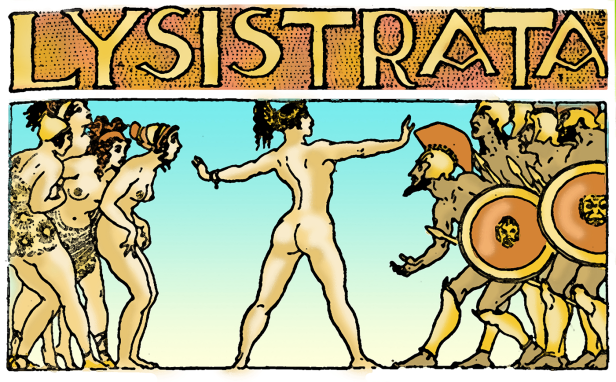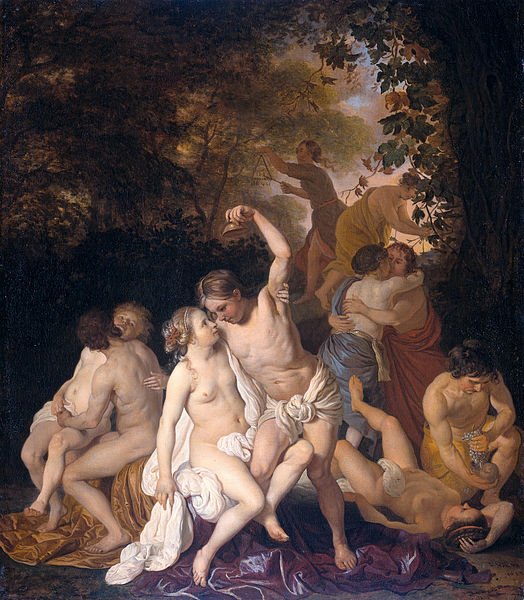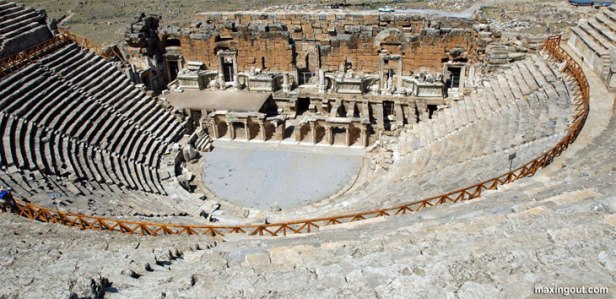Aristophanes’ Audience
William Missouri Down, Lou Anne Wright and Erik Ramsey, together compiled The Art of Theatre in which they use the example of Aristophanes’ Lysistrata (411 BCE) to explain the ‘Theatre of protest’. According to them, “Theatre of protest vents hostility toward the ruling class, race or culture” and is a type of theatre with the purpose of protest and change. Lysistrata is often termed as the ‘anti-war-comedy’ because Aristophanes fuses two strong forces, sex and war, to question the conventions attached to both. He represents rational women and frail warriors, and creates a comic effect on stage. Such a presentation at the time of the Peloponnesian War was a bold statement against the glorified idea of war (or Kleos, as explained in classical texts like Homer’s The Iliad). However, the space of the theatre allowed for such radical advancements.
The plays of the era were mostly performed at the City Dionysia or Lenaea which were Bacchic festivals in honour of the god Dionysus. These festivals displayed the wealth of Athens, political, cultural and musical, and served as an open space for varying perspectives and opinions, even if they were against the State. Lysistrata begins with a reference to the Bacchic celebrations, which continues throughout the play, time and again. This hints towards Aristophanes’ intent to create a similar space as that of the City Dionysia, within the play, to render a sense of freedom and liberty. According to Alan H. Sommerstein in the Introduction to the play, this liberty extended to the audience where “There seem to have been no restrictions of age, gender or citizen status governing attendance.” People from all sections of society were welcomed to enjoy the performance because the festival evoked a temporary space where hierarchies were more fluid. However, only male actors were allowed to perform and front seats were reserved for Athenian priests and officials (who belonged to the male gender). The most privileged seat of all, the centre place in the front row, was reserved for the priest of Dionysus. In spite of this, Michael Bakhtin in Revelry and the World associates this festival with a complete inversion of authority, where the marginalised, temporarily, experienced a certain utopian victory over dominant order. Such a spirit is reflected by Aristophanes, in the projection of the Magistrate as a biased, corrupt and unworthy official, who is emasculated and forced to leave the action of the play. To represent the functionaries of the State in such a light at the Bacchic festivals, where they possibly assumed the front row seats, is conceivable proof of the freedom offered, exclusively, within this space. This sentiment is heightened because of the scale of these festivals with many visiting foreigners. Hence, Lysistrata thrived, despite (or perhaps, for) its social and political comment.
While the male priests and officials occupied the front rows, the foreigners and women may have been segregated in the back rows because of their low social status within Athens. The dominance of the patriarchal culture lead even the women to believe that they deserved back row seats, for a play attempting to invert this very ideology. Aristophanes illuminates another cultural attitude, Ratiocentricism which places rationality in prime importance. In his Comedy, he inverts the idea of women being irrational beings by portraying them as creatures who are in control of their sexuality. Centuries later, Michel Foucault talks about the conditioning of women by society which leads them to believe that providing sexual pleasure as a duty to their husbands is the highest end of their lives. Aristophanes talks about female sexual desire but not sexual duty because such an ideal does not fit into the society of Lysistrata where the women control the action. The play is heavily populated with women, and their unity and determination overpowers the male dominant authority prevalent in the play, as well as in society. A comparable, though intensified, atmosphere is created in the Wife of Bath’s Tale by Geoffrey Chaucer, wherein, he portrays a matriarchal society in a proto-feminist spirit. Even the eponymous protagonists from the two texts can be paralleled in their wit, confidence and strength. Sommerstein points out that one passage in Lysistrata (line 1051) – though only one – makes an explicit reference to the presence of women. This shows the acknowledgement of the female segment of the audience, by the playwright.
Aristophanes shook the foundations of the stereotypes attached to women by illustrating “real women” like Lampito who has bodily integrity and intellectual prowess. Her ‘masculine’ physique also helps the audience break away from conventional ideals of defining feminine beauty as frailty. These advances possibly had a lasting effect on the audience and compelled them to question their own ways, thus, having a purpose of protest and change, for a better society. This can be related to the cathartic function of a Tragedy which according to Aristotle in Poetics allows the audience (members of society) to purge their emotions within the theatrical expanse, in order to perform better in the State. Although, we witness an inversion of the inversion, which re-establishes male superiority. It is conjectured by some critics that perhaps, Aristophanes restored the original form of society because the majority of the audience demanded that, and so was the conventional structure of the Comedy. Also, there was always the threat of his life ending like that of Socrates, if he went against the demands of the audience and the people of power. There existed many such external forces influencing the voice of the writer or poet (as the term was used at the time), which restricted his work. For instance, beyond the extents of the Bacchic festivals, women were majorly prohibited from theatres. Maybe, only a small elite section was allowed to watch theatre along with other men. The oppression of male hegemony is best evidenced in the gender of the priest himself (who was a part of the audience) because traditionally, the priests of Dionysus were supposed to be women but by this time they were men.
There existed an exclusive attitude within the democracy of the Athenian government, as highlighted by Lysistrata when she explains the metaphor of wool-carding, whereby, she devises a strategy to run the government, which would include all sections of society. In the Athenian democracy, women and slaves didn’t have the right to vote in spite of comprising more than half the population. The people of Athens were also deeply xenophobic, hence, families consisting of any foreigners weren’t allowed to vote either. This allowed the elite class of men to resume official posts easily, almost as if they were reserved, and run the State without much interference from any sort of opposition, much like the tradition of reserving seats for such men in the theatre. However, these boundaries do melt to a great extent during the festivals of Lenaea and City Dionysia, wherein, these marginalised sections could share the theatre with the upper classes and other ‘desirable’ sections of society. In fact, people from all over Greece came to attend these festivals and were welcomed and accepted. There was another kind of audience functioning within these liberal spaces. As suggested by Sommerstein, “sometimes, [the poets] would recite samples of their works to the magistrate” who would select the works which would be performed at the festivals. The prizes were allotted by a panel of judges who were believed to be strongly influenced by the preference of the audience as a whole. Ergo, the composition of the audience of the play was extremely different from the composition that society would approve of beyond the space of the theatre and the festival. Even in the play, the audience is sometimes addressed as if it consisted of only men. For example, towards the end Lysistrata confirms the reconciliation by addressing the men of power, “Well gentlemen, so it’s all happily settled” (line 1273).
The play seems to be catering to male desires in its pornographic elements such as overt physical comfort displayed among the women, stripping off clothes, nudity – representing the kingdom on a naked female body, etcetera. This emphasizes the fact that men were the majority in the audience and focuses our attention on the female objectification. Moreover, the play resolves in the restoration of male authority even though it is the women who have proved their capacity throughout the play. Such a reconciliation, which has been conducted by a woman yet glorified men is a subtle social commentary (maybe even unintentional). It reminds of the patriarchal society and its presumptions. Lysistrata appears to be emancipating the female gender, but is in fact stating the dependence of women over men. This is aptly depicted when Lysistrata attempts to justify herself in terms of her father (or patriarchal authority), “I’ve often heard my father’s conversations” (line 1127). This echoes the situation of women in reality, who are constantly defined by their patriarchal authority and are made to occupy the back row seats in a theatre, simply by the virtue of their gender. The hypocrisy of such an attitude is also existent in the play, along with Athens. The play is centred on the Acropolis, temple of goddess Athena. The men seem to be devout worshippers of the goddess who feel the same kind of right of possession over her as they do over their wives and thus, “Our women” (line 260) parallels with “our Goddess” (line 303).
Echoing Plato’s distinction between ‘form’ and ‘substance’ as expounded in The Republic, Lysistrata follows the conventional use of the presence of the phallus, which defines the absence of female sexuality. This highlights the true social position of women in the play, theatre (where they weren’t allowed to perform and had to occupy back row seats) and society. The composition of the audience was complex because of the restrictions which existed even within a space as free as City Dionysia. Amnesty was prevalent but equality was not. The male members of society occupied a larger space than other sections like women, foreigners and slaves, combined. The marginalisation of these sections is well depicted in Aristophanes’ Lysistrata, where the women who are marginalised themselves, raise the issues of an exclusive democracy and the futility of war.



Not indicating that the content you copy/paste is not your original work could be seen as plagiarism.
Some tips to share content and add value:
Repeated plagiarized posts are considered spam. Spam is discouraged by the community, and may result in action from the cheetah bot.
Creative Commons: If you are posting content under a Creative Commons license, please attribute and link according to the specific license. If you are posting content under CC0 or Public Domain please consider noting that at the end of your post.
If you are actually the original author, please do reply to let us know!
Thank You!
More Info: Abuse Guide - 2017.
I am the original writer of this paper. I have cited sources which have been used to make my point clearer. You can also find my work on my blog https://thefablesoup.wordpress.com/author/vidishakhaitan/.
Hi! I am a robot. I just upvoted you! I found similar content that readers might be interested in:
https://thefablesoup.wordpress.com/2015/12/12/aristophanes-audience/